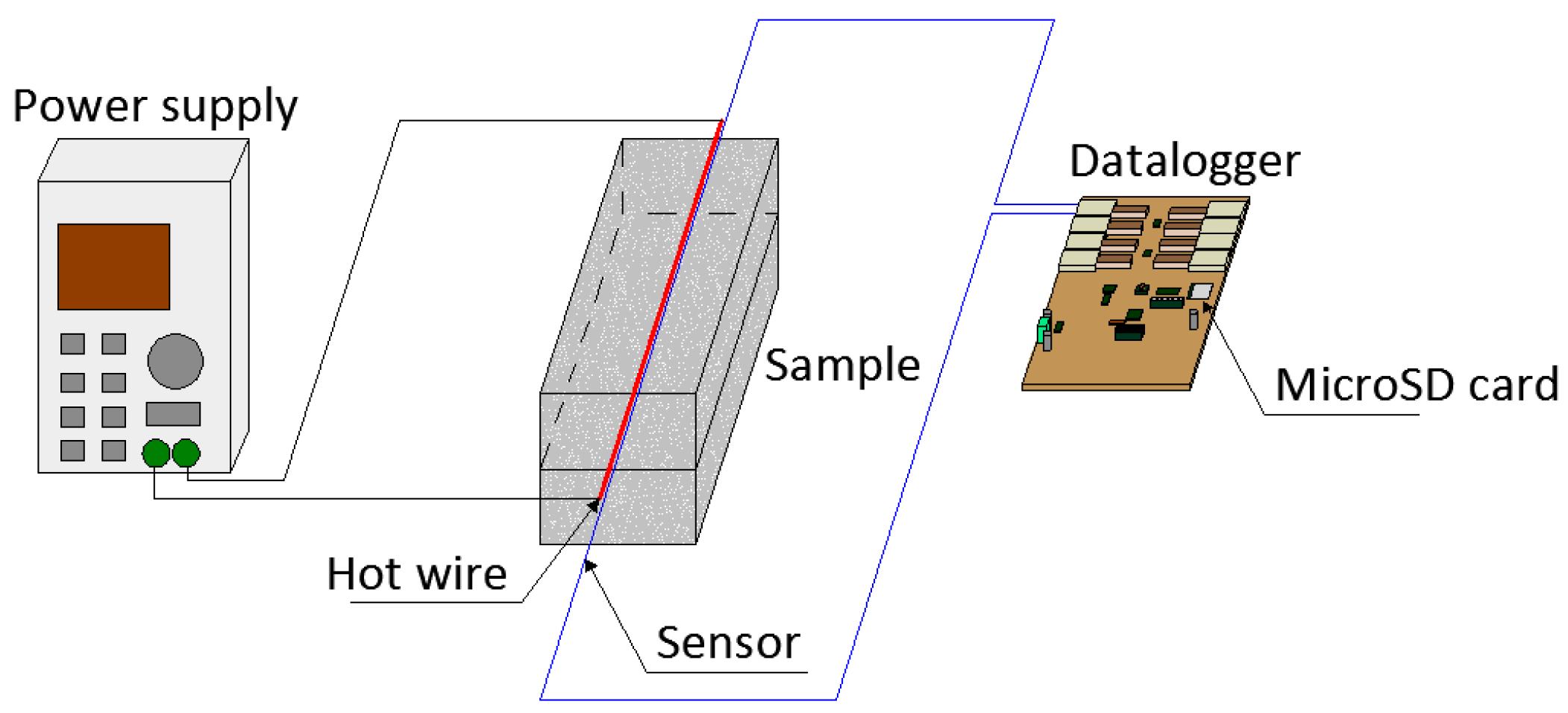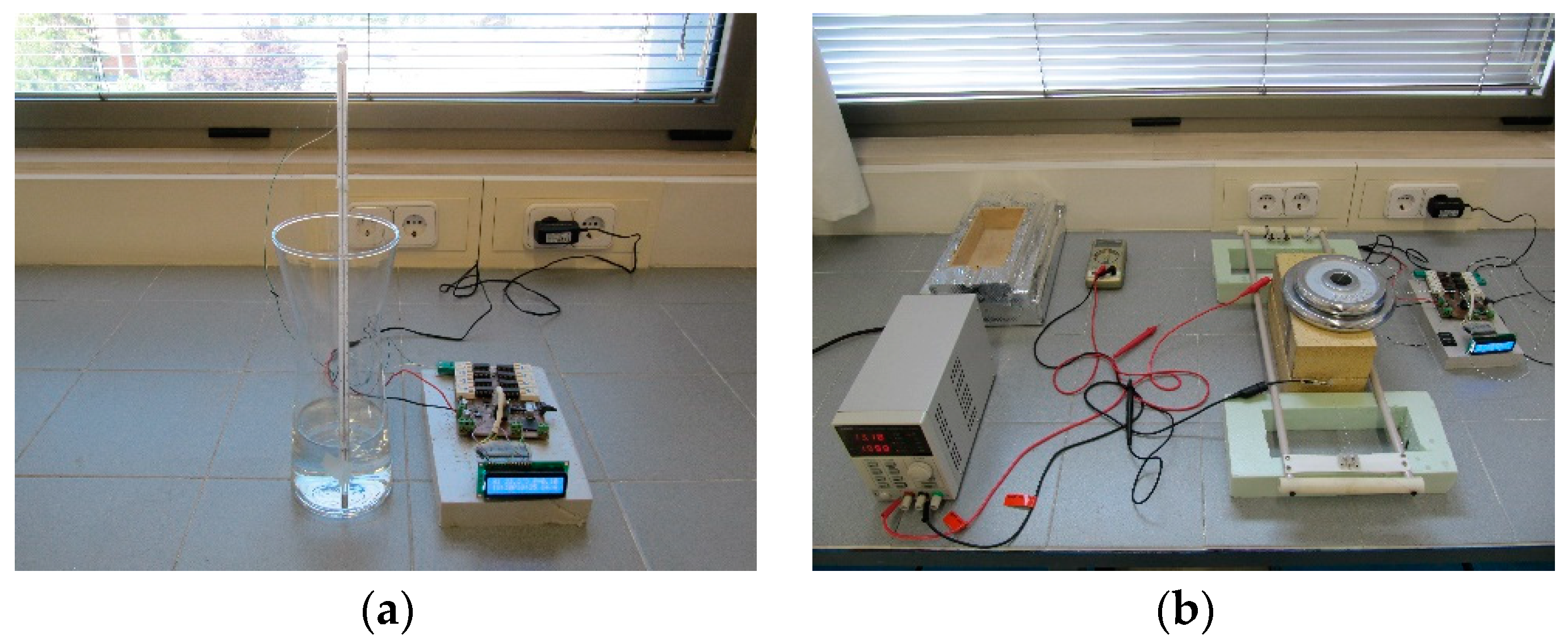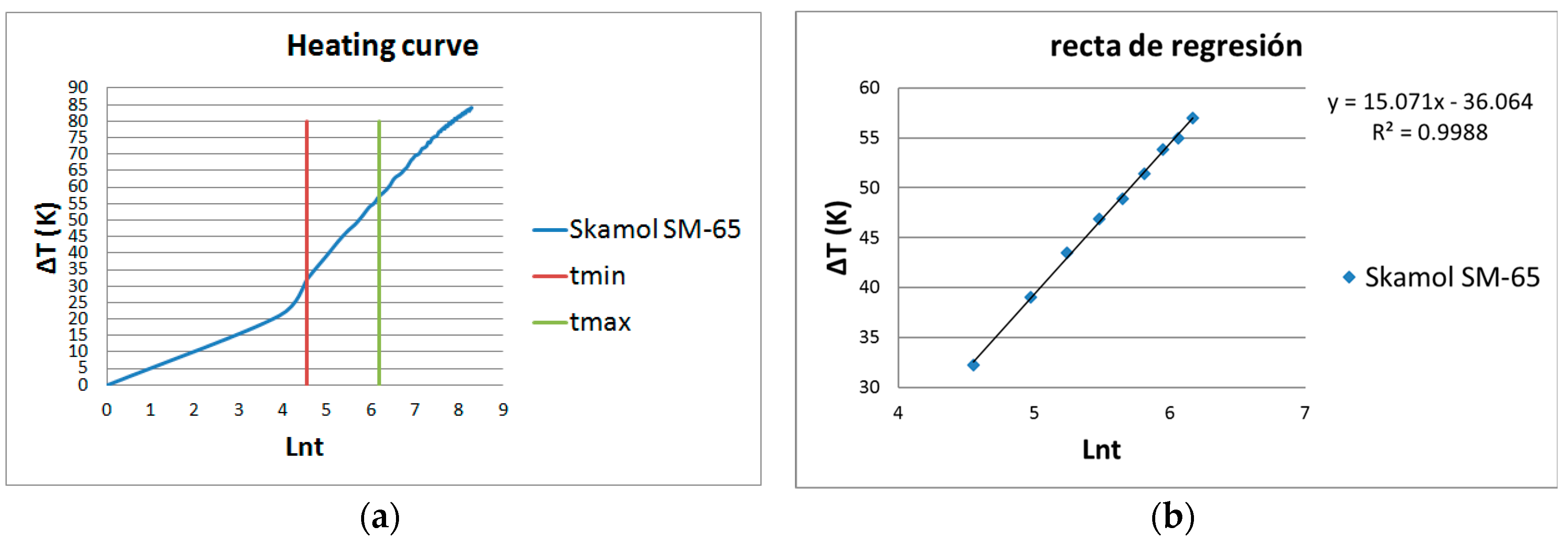Design, Construction and Commissioning of an Apparatus for Measuring the Thermal Conductivity of Geothermal Grouting Materials Based on the Transient Hot Wire Method †
Abstract
:1. Introduction
2. Materials and Methods
2.1. Theoretical Basis
2.2. Apparatus
2.3. Tests
- Placement of the sample.
- Placement of the weight of 5 kg on the sample.
- Selection of the electrical current (0–3 A).
- Beginning of the heating and the data logging at the same time.
- Voltage drop measurement using a multimeter.
- Hot wire length measurement using a flexometer.
- End of the heating and the data logging after 15 min.
- Download the microSD card from the datalogger to the computer.
- Plotting the heating curve.
- Obtaining the thermal conductivity.
3. Results and Discussion
4. Conclusions
- A precise and accurate apparatus based on the transient hot wire method has been designed and constructed. This apparatus, named MCT, allows measure the thermal conductivity of geothermal grouting materials in a few minutes. In addition, the MCT apparatus is light and with reduced dimensions.
- The commissioning of MCT has been carried out by means of the calibration of the K-type thermocouple sensor using a mercury thermometer, as well as the measurements of thermal conductivity using four reference samples with a thermal conductivity in the range of (0.13–2.80) W/m∙K. In all cases the uncertainty of the measurements is within 10%.
Author Contributions
Acknowledgments
Conflicts of Interest
References
- Dos Santos, W.N. O método de fio quente: Técnica em paralelo e técnica de superfície. Cerâmica 2002, 48, 86–91. [Google Scholar] [CrossRef]
- Dos Santos, W.N. Métodos transientes de troca de calor na determinação das propiedades térmicas de materiais cerâmicos: II–o método do fio quente. Cerâmica 2005, 51, 371–380. [Google Scholar]
- Coquard, R.; Baillis, D.; Quenard, D. Experimental and theoretical study of the hot-wire method applied to low-density thermal insulators. Int. J. Heat Mass Transf. 2006, 49, 4511–4524. [Google Scholar] [CrossRef]
- Franco, A. An apparatus for the routine measurement of thermal conductivity of materials for building application based on a transient hot-wire method. Appl. Therm. Eng. 2007, 27, 2495–2504. [Google Scholar] [CrossRef]



| Sample | Material | λ [W/m∙K] |
|---|---|---|
| Skamol SM-65 | Diatomite | 0.13 |
| Macizo M5R | Red clay | 0.70 |
| MAXIAL 310 | Chamotte | 1.20 |
| CN-90BA | Alumina | 2.80 |
Publisher’s Note: MDPI stays neutral with regard to jurisdictional claims in published maps and institutional affiliations. |
© 2018 by the authors. Licensee MDPI, Basel, Switzerland. This article is an open access article distributed under the terms and conditions of the Creative Commons Attribution (CC BY) license (http://creativecommons.org/licenses/by/4.0/).
Share and Cite
Castán-Fernández, C.; Marcos-Robredo, G.; Rey-Ronco, M.Á.; Alonso-Sánchez, T. Design, Construction and Commissioning of an Apparatus for Measuring the Thermal Conductivity of Geothermal Grouting Materials Based on the Transient Hot Wire Method. Proceedings 2018, 2, 1496. https://doi.org/10.3390/proceedings2231496
Castán-Fernández C, Marcos-Robredo G, Rey-Ronco MÁ, Alonso-Sánchez T. Design, Construction and Commissioning of an Apparatus for Measuring the Thermal Conductivity of Geothermal Grouting Materials Based on the Transient Hot Wire Method. Proceedings. 2018; 2(23):1496. https://doi.org/10.3390/proceedings2231496
Chicago/Turabian StyleCastán-Fernández, Carlos, Germán Marcos-Robredo, Miguel Ángel Rey-Ronco, and Teresa Alonso-Sánchez. 2018. "Design, Construction and Commissioning of an Apparatus for Measuring the Thermal Conductivity of Geothermal Grouting Materials Based on the Transient Hot Wire Method" Proceedings 2, no. 23: 1496. https://doi.org/10.3390/proceedings2231496
APA StyleCastán-Fernández, C., Marcos-Robredo, G., Rey-Ronco, M. Á., & Alonso-Sánchez, T. (2018). Design, Construction and Commissioning of an Apparatus for Measuring the Thermal Conductivity of Geothermal Grouting Materials Based on the Transient Hot Wire Method. Proceedings, 2(23), 1496. https://doi.org/10.3390/proceedings2231496





